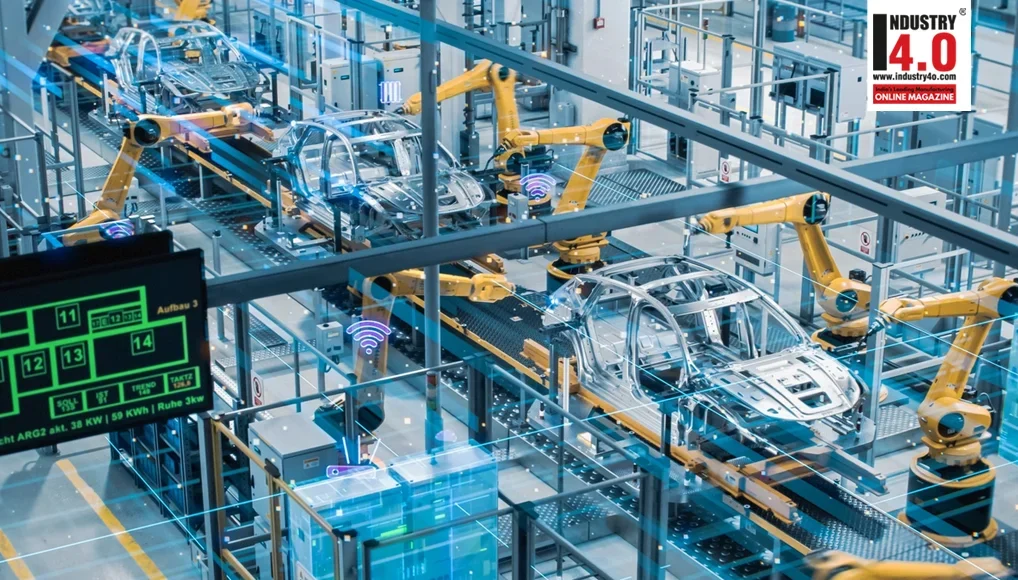Digitisation in Manufacturing
Industry 4.0 is the era of smart manufacturing, the “next big thing” for factories and businesses. As per the RBI’s 64th OBICUS survey, capacity utilization of manufacturing companies rose to 74.7% in the quarter ending December 2023, up from 74% in the September 2023 quarter and 73.6% in the June 2023 quarter. The survey included 813 companies. (Source)
At its core, it’s built on four key pillars:
– Internet of Things (IoT)
– Big Data and Analytics
– Artificial Intelligence (AI)
– Automation
It goes without saying, that digitisation is the backbone of all 4 pillars of Industry 4.0, transforming traditional manufacturing into a data-driven industry. This approach lets businesses capture real-time data, automate processes, and improve efficiency. Let’s start by understanding what Industry 4.0 means for Indian manufacturers.
What Does Digitization Mean for Indian Manufacturing?
Digitisation means moving away from manual or paper-based processes to digital solutions and shifting from outdated ledgers and disconnected systems to connected, and real-time approaches. It means replacing spreadsheets and paperwork with easy-to-use software and automated workflows.
Read What Is a Digital Document? to understand this better.
India is steadily advancing towards Industry 4.0 with government initiatives such as the National Manufacturing Policy. Its goal is to further improve the manufacturing sector’s contribution to GDP to 25% by 2025. Additionally, the PLI scheme, launched in 2022, focuses on elevating the core manufacturing sector to meet global standards (source).
For manufacturers, this transition isn’t just a matter of convenience—it’s a necessity to stay competitive. Industry 4.0 makes SMEs capable of competing with large industries in the market and scaling their businesses.
Top 5 benefits of digitisation in manufacturing:
1. Reduced Waste: Industry 4.0 helps you use your resources, whether people or machines, more efficiently. It analyzes worker and machine strengths to assign tasks better and spot time-wasting processes. This reduces waste of time and resources.
2. Easy Document Management: Industry 4.0 simplifies tasks like data entry, record keeping, and compliance with GST. This keeps your business aligned with regulations, avoiding legal troubles and reducing misunderstandings with suppliers and customers.
3. Better Inventory Management: With Industry 4.0, you can optimize inventory based on production and orders. It helps plan raw material needs, alerts you when stock is low, and avoids overstocking. This minimizes disruptions and cuts inventory costs.
4. Higher Operational Efficiency: Industry 4.0 improves operations by identifying bottlenecks, reducing errors, and speeding up processes. It helps you organize tasks to meet targets, boosting overall efficiency. Real-time monitoring helps in adhering to standard operating procedures and allows quick inspections. This reduces defects and enhances product quality.
5. Flexibility and Adaptability: Industry 4.0’s cloud-based tools let you manage your business remotely with just an internet connection. You can quickly adjust strategies, change production volumes, and respond to market demands, improving overall flexibility.
Digitisation helps you to track production, monitor inventory, and maintain quality control all in one place. This real-time data visibility helps you make faster, better decisions and respond quickly to market demands. We have written a detailed 2 part blog post on How Industry 4.0 Is Transforming Manufacturing Industry.
Key Technologies for Digitisation in Industry 4.0
India’s manufacturing sector has the potential to grow to US$ 1 trillion just by 2025. The introduction of the Goods and Services Tax (GST) will unify India into a single market with a GDP of US$ 3.4 trillion and a population of 1.48 billion, making it highly attractive to investors (source). The key technologies that are a part of Industry 4.0 are:
1. Internet of Things (IoT)
IoT connects physical devices, sensors, and machines to gather and share data, creating a connected ecosystem. This enables businesses to monitor operations in real time and make data-driven decisions.
2. Digital Twins
Digital twins are virtual models of physical processes, machines, or systems. They allow manufacturers to simulate, analyze, and optimize their processes without disrupting the actual operations.
3. Edge Computing
Edge computing brings data processing closer to where it’s generated, allowing for quicker insights and real-time actions. This reduces delays and improves responsiveness on the shop floor.
4. Cloud Platforms
Cloud platforms centralize data storage and processing, helping with easy access, scalability, and remote management. This flexibility allows manufacturers to manage operations efficiently, even from different locations.
5. Data Analytics and AI
Data analytics and AI unlock the potential of big data by identifying trends, predicting failures, and optimizing processes. This improves productivity, and quality, and drives continuous improvement.
Common Challenges of Industry 4.0 for Indian Manufacturers
While Industry 4.0 offers immense growth potential, Indian manufacturers often face several challenges in adopting these new technologies:
1. High Initial Costs
Implementing Industry 4.0 technologies like IoT, AI, and automation requires a significant initial investment. For many Indian SMEs, these high costs can be a major hurdle, making it difficult to transition from traditional methods to smart manufacturing.
2. Lack of Skilled Workforce
The shift towards digital manufacturing demands a workforce with technical skills and an understanding of new technologies. Many small and mid-sized manufacturers struggle to find and retain employees with the necessary expertise to operate and maintain advanced systems.
3. Data Security Concerns
With increased digital connectivity and data exchange, concerns about data privacy and cyber threats become more pressing. Indian manufacturers must address these issues to protect their operations and sensitive business information.
4. Integration Issues with Legacy Systems
Most Indian manufacturers have existing legacy systems that are not easily compatible with modern Industry 4.0 technologies. Integrating new digital solutions with these outdated systems can be complex and time-consuming.
5. Limited Awareness and Understanding
Many business owners and decision-makers still lack a clear understanding of what Industry 4.0 involves and its benefits. Without adequate awareness, it’s challenging for manufacturers to commit to the required changes and investments.
Introducing TranZact
At TranZact, we understand the unique challenges that Indian SME manufacturers face in embracing Industry 4.0. Our mission is to simplify and streamline manufacturing processes, helping you achieve digital transformation with ease. TranZact is a complete, cloud-based solution designed specifically to address the pain points of Indian SME manufacturing businesses.
 What is TranZact?
What is TranZact?
Unlike traditional ERP systems or standalone or custom ERP solutions, TranZact is specially made for Indian SME manufacturers, combining ease of use with powerful features. We are the go-to digital solution that integrates your entire manufacturing process—from enquiry to dispatch—into one platform. Our focus is on simplicity, ease of use, and real-time control. We want to make sure that you can implement TranZact in the least time possible.
Why TranZact?
What differentiates TranZact from other alternatives is our deep understanding of the needs of Indian SMEs.
We have built our platform around the key challenges of Indian SME manufacturers:
1. Ease of use:
Many Indian SMEs face difficulty in finding employees with advanced technical skills or training existing staff. To solve this, TranZact offers an intuitive, user-friendly interface that requires minimal training.
We’ve kept the design simple and the features easy to navigate, so anyone in your team can start using it quickly without needing extensive technical knowledge. This ease of use reduces the need for expensive and time-consuming training programs and empowers your existing workforce to embrace digital tools confidently.
2. Quick Implementation:
We understand that most manufacturers have existing processes and systems in place, which can make adopting new technology seem overwhelming. TranZact is designed for quick implementation, in just 14 days, with minimal disruption to your current operations.
TranZact easily integrates with your existing systems, letting you quickly transition to a more efficient, digital-first workflow. This quick setup helps you see results faster, making sure you stay ahead of the competition without prolonged downtime or complicated onboarding.
3. 24*7 Chat Support:
Using new technology can be complicated, and having immediate support is non-negotiable. That’s why TranZact offers round-the-clock chat support to address any concerns or questions you might have. Whether you’re troubleshooting an issue, seeking advice on optimizing your operations, or need clarity on features, our dedicated support team is available to assist you at all times. This commitment to support gives you peace of mind and builds confidence in navigating your digital transformation journey. By prioritizing ease of use, fast implementation, and 24/7 support, TranZact gives Indian SME manufacturers the power. TranZact is a partner in your growth journey, helping you focus on what matters the most, business growth!
Case Study: Valvetork
ValveTork, a medium-sized valve manufacturer, was struggling with outdated, manual processes that made it difficult to reconcile data from backdated documents and manage daily operations efficiently. Without a unified system, they lacked real-time visibility across departments, leading to frequent errors, miscommunication, and delayed orders. The management realized they needed to digitize their operations but found most existing ERP solutions too costly and complex for their needs.
Challenges:
ValveTork‘s reliance on manual data entry and paperwork meant they had to deal with inaccurate data and poor coordination between sales, inventory, and production. This often led to problems like over-ordering, missed deadlines, and an inability to meet growing customer demand. Scaling their business was difficult because they didn’t have accurate, up-to-date information to make informed decisions.

TranZact’s Features Addressing Challenges:
To tackle ValveTork‘s operational inefficiencies, TranZact became a comprehensive solution that digitized and automated processes. Here’s how TranZact helped them transform their operations.
● Digitization of Processes: TranZact digitized every step of ValveTork‘s process, from initial customer enquiry to final product dispatch. This removed the chances of manual errors, reduced paperwork, and provided a clear, digital trail for all transactions.
● Real-Time Data and Integration: With TranZact, ValveTork gained real-time visibility over their entire workflow, including inventory levels, order statuses, and production schedules. Teams could now access accurate information instantly, improving coordination across departments.
● Ease of Use and Implementation: The platform’s user-friendly design allowed staff to quickly adopt it without needing extensive training. Integration was seamless, minimizing downtime and disruption during the transition.
Solution vs. Impact:
After implementing TranZact, ValveTork achieved impressive results.
● They saw a 30% reduction in lead times, which allowed them to fulfil customer orders faster.
● Improved order accuracy meant fewer customer complaints and a better reputation.

TranZact’s simple, user-friendly interface meant that employees could quickly learn how to use the platform, so the company saw immediate benefits without having to invest in long, costly training sessions. This rapid adoption helped them achieve a faster return on investment (ROI) and set them up for future success.
Future Prospects: With TranZact, ValveTork is now well-positioned for growth. They can make more informed, data-driven decisions, which allows them to identify new business opportunities. Their operations are more efficient, and they’re better equipped to handle fluctuations in demand. Going forward, they plan to use these insights to expand their product lines and enter new markets, all with the support of a system that can grow alongside them.
Steps for Manufacturers to Kickstart Their Digitization Journey:
As an Indian SME manufacturer, here is how you can start your digitisation journey.
1. Evaluate Current Processes
Before diving into digitization, it’s important to evaluate which areas of your business are most ready for transformation. Identify the processes that would benefit the most from automation and data integration. Whether it’s inventory management, production monitoring, or order tracking, understanding where to start helps prioritize your efforts effectively. For example, one of our customers said – “When we began evaluating our operations, we realized that our inventory tracking was a major bottleneck. We decided to automate this part first, and within months, our inventory accuracy improved by over 80%, allowing us to fulfil orders faster.” Once the inventory management was taken care of, they expanded into other areas of the manufacturing process.
2. Start Small, Scale Fast
Launching a large-scale digital initiative can be overwhelming, so starting with pilot projects is often a smart approach. By implementing digital tools in a specific area, you can demonstrate their effectiveness and value. Once you see the benefits, you can gradually expand these solutions across other parts of your business for maximum impact.
3. Invest in Digital Skills
The success of digitization relies heavily on your workforce’s comfort and expertise with new technologies. Invest in training your employees to make sure they understand how to use digital tools and platforms effectively. This helps build confidence and increases the efficiency of your digital initiatives.
4. Partner with Experts
Partnering with specialists who understand industrial digitization can save you time and resources. Experts like TranZact can help guide you through the transition, offering tailored solutions that fit your specific needs. This partnership helps with a smooth and successful implementation, paving the way for a scalable digital strategy.
The Future of Digitization in Industry 4.0
The journey of digitization in manufacturing is just getting started, and the future has even more exciting changes in store. Here are some key trends, we think, shaping the future of Industry 4.0:
1. Hyperconnected Ecosystems
Manufacturers will move beyond working in isolation and become part of highly connected ecosystems. Digital platforms will allow seamless collaboration between suppliers, manufacturers, distributors, and customers. This interconnected environment will provide better visibility, improve supply chain efficiency, and encourage new ideas through shared data. Imagine a system where real-time updates, demand forecasting, and production planning all happen smoothly together, leading to faster and smarter decisions.
2. Autonomous Decision-Making
Artificial Intelligence (AI) is advancing from just analyzing data to making decisions on its own. In the future, AI-powered systems will not only gather and study information but also take real-time actions without human help. These systems will optimize workflows, predict equipment breakdowns, and adjust production based on demand. This will help manufacturers achieve more efficient and flexible operations.
3. Sustainability through Digitization
As sustainability becomes more important, digitization will help manufacturers optimize energy use and reduce waste. Digital systems will enable real-time monitoring of resource consumption, predictive maintenance to avoid downtime, and better inventory control to prevent overproduction. With data-driven insights, manufacturers can achieve greener operations, aligning with global goals for sustainability and building a stronger reputation.
Conclusion: A Digital-First Future
If you’re a manufacturer looking to future-proof your business, now is the time to assess your digital readiness and take the first step towards digitization. Learn more about how adopting the right digital tools can transform your operations and drive growth. At TranZact, we’re here to guide you on this journey.
Ready to take your first step towards a digital-first future? Schedule a consultation or book a demo with us today to see how TranZact can help you achieve your digitization goals and lead your business to success.
About the Author:

Mr. Ritesh Kumar
Co-Founder & CEO
TranZact
Mr. Ritesh Kumar co-founded TranZact in 2017 along with Mr. Rohan Sen Sharma & Mr. Sharad Sen Sharma.
Mr. Ritesh Kumar With over 5+ years of experience in the Investment Banking and Private Equity, have honed skills across B2B business, SME business, product design, business strategy, private equity, and investment banking.
Mr. Ritesh Kumar journey, grounded in the education he received at IIT Kharagpur, and has equipped him to lead TranZact with vision and purpose.
Mr. Ritesh Kumar vision is to build & grow TranZact towards its mission to digitize millions of SMEs.
Mr. Ritesh Kumar can be Contacted :
Email | LinkedIn | Mobile : +91 – 9769913548
About TranZact :
 At TranZact, we are building an ecosystem that consists of a suite of cutting-edge software and applications. These tools are designed to help businesses streamline their internal operations, connect with other companies, discover new opportunities, and execute trades with unprecedented ease. Our goal is to empower companies to make faster and smarter decisions using the data we generate.
At TranZact, we are building an ecosystem that consists of a suite of cutting-edge software and applications. These tools are designed to help businesses streamline their internal operations, connect with other companies, discover new opportunities, and execute trades with unprecedented ease. Our goal is to empower companies to make faster and smarter decisions using the data we generate.
TranZact is 100% made in India by a team of passionate IIT/IIM graduates.
At TranZact, we are not just building a company; we are fostering a movement towards a future where SMEs can thrive and innovate like never before.
To Contact TranZact :
Email | Web | FaceBook | Instagram | LinkedIn | YouTube | Twitter
See a live demo today of TranZact Solutions












